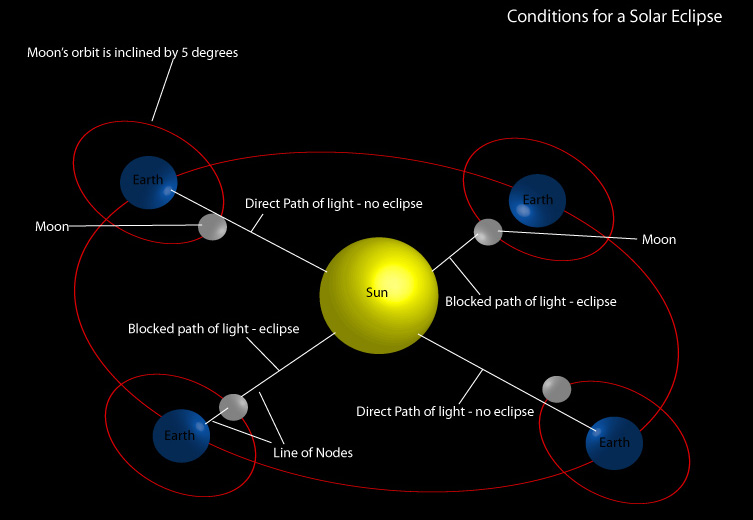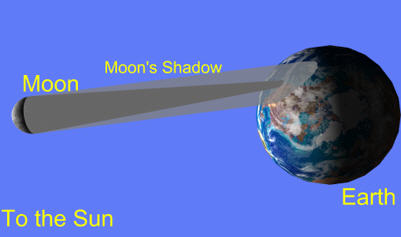|
Please be sure to read our
Solar Viewing
Safety page. The
ecliptic is the a virtual plane that splits the
Sun in half. Along
this plane
orbits the 9 planets, their moons and the
asteroids. Our Moon travels
about this same plane so there are times when the
Moon comes between the
Earth (which leads to a solar eclipse) and other times when the
Moon is "behind" the
Earth (which leads to a
lunar eclipse). It is
important to realize that this
ecliptic is only an apparent plane as the
orbits
are inclinated by various degrees. In other words, the planet
orbits are not
required to rotate on this plane. Same is true for our
Moon - in fact, our
Moon's
orbit has an inclination of 5°. This inclination is
important because this is the reason for having a variety of eclipse types -
i.e. partial or total.
In addition to an inclination, all
orbits also have a
slight elongation. It is very rare, and safe to say impossible, for an
orbit of
a body about another body to be an perfect circle. According to Newton's Law,
objects with mass will affect other objects with mass. As
Earth
orbits the
Sun
because of the gravity attraction by the
Sun,
Earth's mass also affects the
Sun
(although very little, but this can still be measured). The result is an
elliptical
orbit. This measured result is called eccentricity.
 |
| The figure above demonstrates the conditions required for and
eclipse to occur. When the
Earth,
Moon
and
Sun
lay on the same plane, this is called the Line of Nodes. |
Because of the inclination and elongation of
Moon's
orbit about
Earth, there
are three variations of a Solar Eclipse.
 |
For some nice animations of a Solar Eclipse, click on the images to
the right and left. The image on the right demonstrates a total
eclipse. The image on the left shows how the shadow moves across Earth.
The darker shadow will be the locations of a total eclipse while the
lighter shadow will be the locations of the partial eclipse (videos care
of Swinburne
Astronomy Online). |
 |
If the umbra is focused to a point on
the Earth's surface, a total solar eclipse will occur.
If the umbra is focused above the
Earth's surface, an annular eclipse will
occur.
If the
Moon
orbits just above or below the Line of Nodes, a partial solar
eclipse occurs. Notice the absence of a defined Umbra.
For a list of Solar Eclipse dates, click
here.
For Lunar Eclipse information, click
here. To go
back to Our
Sun, click
here.
Back to Top |

